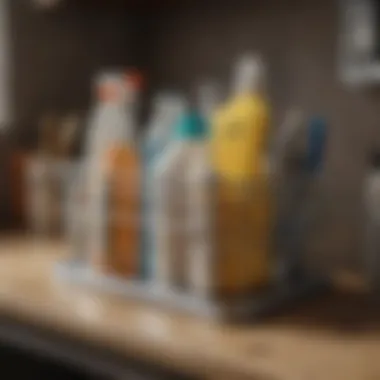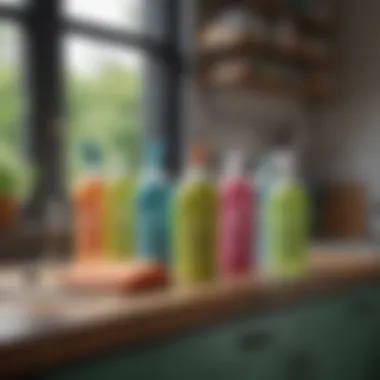Essential Home Cleaning Tools and Supplies Guide


Intro
Maintaining a clean home is vital for both health and well-being. A well-organized space not only boosts productivity but also enhances the aesthetic of your environment. This article will uncover the essential tools and supplies necessary for effective home cleaning. It will highlight key points, methods, and best practices to equip any homeowner or cleaning enthusiast with the means to uphold a tidy and welcoming living area.
Importance of a Clean Home
A clean home reduces allergens and pathogens. The air quality improves with regular cleaning. Furthermore, a tidy environment has a positive impact on mental clarity. Understanding the right materials and methods can make a significant difference in how effectively one can maintain cleanliness.
Key Cleaning Areas
Focus areas often include:
- Kitchens
- Bathrooms
- Living areas
- Bedrooms
Each space has unique cleaning challenges, thus requiring tailored tools and supplies. Identifying these needs is crucial for effective home cleaning.
Understanding the Basics of Home Cleaning
A clean home contributes significantly to overall well-being. Understanding the basics of home cleaning is essential for maintaining a healthy environment. Not only does a clean space promote physical health, but it also supports mental clarity. When the space is clutter-free, it can reduce stress levels and enhance productivity.
The process of cleaning goes beyond just aesthetics. It helps in prolonging the life of furniture and appliances. Regular cleaning prevents the accumulation of dirt and grime that can cause damage over time. Understanding when and how to clean each part of the home is vital. This knowledge will empower homeowners to create efficient cleaning routines.
The Importance of a Clean Home
A clean home ensures good hygiene. Dust, mold, and allergens can trigger health issues. Many people might underestimate the benefits of a well-maintained living space. A home that is clean offers comfort. It makes inviting friends and family over easier. A positive atmosphere is created in a tidy environment.
Creating a Cleaning Schedule
A cleaning schedule acts as a roadmap for maintaining cleanliness. It helps in organizing tasks and ensures that no area is neglected. Homeowners can break down chores into manageable sections, making it easier to follow.
Daily Tasks
Daily tasks are fundamental for keeping a clean space. These tasks include wiping surfaces, making the bed, and doing the dishes. These actions can seem trivial but are crucial for preventing dirt buildup. Their primary characteristic is frequency, leading to sustained cleanliness. Daily tasks allow homeowners to develop strong habits. However, daily cleaning does require commitment and can become tedious if not managed properly.
Weekly Maintenance
Weekly maintenance includes more intensive chores like vacuuming and mopping. These are necessary for deeper cleaning. This aspect of a cleaning schedule helps maintain the overall cleanliness of a home. Weekly tasks are known for their thoroughness compared to daily tasks, making them essential. They can be seen as a beneficial element of any cleaning regimen. One unique feature is that they allow homeowners to identify areas needing attention before they become more troublesome.
Monthly Deep Cleans
Monthly deep cleans involve thorough tasks like cleaning carpets or windows. They are designed to tackle grime that may not be apparent on a daily or weekly basis. The depth of these cleans ensures that every corner of the home is attended to. This makes monthly cleans vital for long-term cleanliness. One advantage of monthly cleans is the ability to refresh and rejuvenate spaces. However, these can be time-consuming and may require advanced planning.
Essential Cleaning Tools
In the realm of home cleaning, the selection of proper tools is paramount. Different tasks require different tools. Thus, knowing which tools are essential can streamline the cleaning process significantly. They not only enhance efficiency but also ensure a deep and thorough clean throughout your living spaces. When you have the right cleaning tools at your fingertips, you can tackle messes with greater confidence and effectiveness. This knowledge is not merely about convenience; it's about maintaining a healthy and pleasant environment.
Vacuum Cleaners
Vacuum cleaners are cornerstone tools in any effective home cleaning toolkit. They serve to remove dust, dirt, and allergens from various surfaces. Being able to select the right vacuum is vital.
Selecting the Right Model
When choosing a vacuum cleaner, consider the intended use. A model designed primarily for carpets may not perform well on hardwood floors. Cordless models offer flexibility but might lack the power of corded versions. Additionally, check for HEPA filters, which are beneficial for allergen control, making this a popular choice among health-conscious homeowners.
A unique attribute of some vacuum models is their specialized attachments. Having these can enhance your ability to clean hard-to-reach areas, such as corners or upholstery. However, the trade-off might be a slightly higher cost.
Usage Techniques
Understanding how to use a vacuum cleaner properly is just as crucial. For optimal results, one should vacuum in straight lines and overlap each pass slightly. This technique captures more dirt and leads to a cleaner environment. Regularly emptying the dustbin or replacing bags is also important for maintaining suction power.
Some users might find it simpler to use a robot vacuum for daily maintenance. These devices automate some tasks but may need complementary deeper cleaning methods for maximum effectiveness.
Mops and Brooms
Mops and brooms are indispensable tools for cleaning hard floors. Each serves a distinct purpose, yet they often work together to achieve the desired cleanliness.
Types of Mops
There are various types of mops available, including sponge, string, and flat mops. Each type has its advantages. Sponge mops are good for absorbing spills, while string mops are excellent for deep cleaning. Flat mops are user-friendly, allowing for easy maneuverability. The right choice hinges on your specific cleaning needs.


A unique benefit of microfiber mops is their ability to trap dust effectively. However, they often require more maintenance, like washing, compared to traditional mops.
Broom Selection
Selecting the right broom also impacts cleaning efficiency. For outdoor surfaces, a heavy-duty broom may be more appropriate, while a soft-bristled broom is ideal for indoor use. Understanding the surface type is key to making an informed choice.
Many modern brooms feature a dustpan that attaches to the handle. This approach can simplify the disposal process, although it may be less effective for fine dust.
Dusters and Cloths
Dusters and cloths play an essential role in removing airborne particles and surface dirt. Their effectiveness depends heavily on the material used.
Microfiber Dusters
Microfiber dusters are highly effective as they can capture and hold dust rather than just pushing it around. This quality makes them suitable for delicate items, like electronics or picture frames. Their softness minimizes the risk of scratches on surfaces.
Though they require washing, their durability makes them a valuable addition to any cleaning toolkit. Often, they can be used multiple times before needing a wash, presenting a good balance of efficiency and maintenance.
Cleaning Cloths
Cleaning cloths come in various materials and sizes, suitable for a wide range of tasks. Microfiber cloths are excellent for streak-free cleaning on glass and shiny surfaces, while cotton cloths are great for general cleaning.
Keep in mind, the choice of cloth material affects its performance. For example, a thicker cloth might absorb more liquid, but it may also take longer to dry.
Scrub Brushes
Scrub brushes are essential tools for tough cleaning jobs. These brushes provide the necessary scrubbing power to tackle grime and stains.
Choosing the Right Brush
When it comes to choosing a scrub brush, bristle hardness is a critical factor. Softer bristles are ideal for sensitive surfaces, whereas firmer bristles are better for rough surfaces. Knowing where you plan to use it guides your choice.
Specialized scrub brushes, often designed for specific tasks like grout cleaning, can provide enhanced results. However, they might be less versatile compared to general-purpose brushes.
Techniques for Scrubbing
Employing the right scrubbing technique can make a significant difference in cleaning effectiveness. Utilize circular motions for stained areas while keeping even pressure to avoid damaging surfaces. Rinsing the brush regularly during use can also improve cleaning outcomes.
Some may find that electric scrubbers reduce effort and improve speed. These machines can be effective, yet they might not be necessary for every cleaning task.
Key Cleaning Supplies
In effective home cleaning, having the right supplies is crucial. These supplies enhance efficiency and help achieve a higher standard of cleanliness. From daily chores to periodic deep cleans, the right tools can influence results significantly. Understanding different kinds of cleaning solutions becomes essential for tackling diverse tasks. This section examines key cleaning supplies that every household should consider.
Essential Cleaning Solutions
Proper cleaning requires effective solutions. The right cleaning solutions can simplify tasks and provide better results. Here are three main types of cleaning solutions:
All-Purpose Cleaners
All-purpose cleaners are versatile products suitable for various surfaces. Their main characteristic is their ability to clean different materials. This makes them a popular choice for many households. Different formulations target specific types of stains and messes. One advantageous aspect of all-purpose cleaners is the convenience they provide. However, some formulations may not be suitable for delicate surfaces like wood, which is a drawback to consider.
Glass Cleaners
Glass cleaners provide a clear and streak-free finish for glass surfaces. They usually contain specific ingredients that effectively cut through grime and fingerprints. Their unique feature is the quick drying time, which is advantageous for busy households. Glass cleaners are essential for maintaining clarity on windows and mirrors. However, users must ensure they do not use them on matte surfaces, as residue may be left behind.
Disinfectants
Disinfectants focus on killing germs and bacteria, crucial for maintaining hygiene. Their key characteristic is their ability to sanitize surfaces effectively. This makes them particularly important in kitchens and bathrooms. Their unique feature is the rapid action against pathogens, ensuring cleanliness and safety. On the flip side, some disinfectants can have strong chemicals, which may not be suitable for all users, especially if there are allergies.
Natural Cleaning Alternatives
Using natural cleaning solutions has become increasingly popular as people become more environmentally conscious. They can be effective and safer for personal use.
Vinegar as a Cleaner
Vinegar is a natural cleaner known for its acidity, which can dissolve mineral deposits and grease. It is popular due to its effectiveness and non-toxic nature. Additionally, vinegar can be used on various surfaces, including countertops and bathroom fixtures. However, the strong smell can be off-putting for some individuals. Proper ventilation is recommended when using vinegar as a cleaner.
Baking Soda for Odor Control
Baking soda is renowned for its deodorizing capabilities. It neutralizes odors effectively, making it a perfect solution for refrigerators and carpets. The key characteristic of baking soda is its ability to absorb bad smells without leaving any residues. It is economical and safe for most surfaces, providing a natural alternative to chemical air fresheners. However, its effectiveness may diminish over time, requiring regular application for consistent results.


Specialized Products
For unique cleaning tasks, specialized products can make a significant difference. These products are formulated to address specific cleaning needs.
Carpet Cleaners
Carpet cleaners are designed to remove stains and dirt from carpets without damaging the fibers. Their primary purpose is deep cleaning, which helps restore carpets’ appearance. A notable feature of these cleaners is their targeted formulations that approach different types of stains. While effective, they may require additional drying time, which could inconvenience homeowners.
Wood Polish
Wood polish enhances the finish of wooden surfaces while providing protection. The key characteristic is its ability to nourish wood, restoring its luster. Wood polish is an excellent choice for maintaining furniture and finished wood floors. At the same time, users should be aware of residue buildup, which may require additional cleaning if not applied correctly.
Room-Specific Cleaning Tips
Cleaning a home effectively requires addressing the unique characteristics of each room. This section highlights the importance of tailored cleaning strategies, ensuring that every area receives the attention it deserves. Each room has different surfaces, appliances, and levels of foot traffic, which necessitates specific cleaning methods. By applying room-specific cleaning tips, homeowners can enhance their cleaning efficiency and ultimately create a healthier living environment.
Kitchen Cleaning Strategies
Countertops and Surfaces
Countertops and surfaces in the kitchen are high-traffic areas that gather dirt and bacteria easily. Regular cleaning is crucial to prevent the buildup of grime and food residues that can affect health. These surfaces often require specific cleaning agents to ensure they are disinfected properly.
Common Materials
Countertops can be made of various materials such as granite, laminate, or quartz. Each material has its own cleaning requirements. For instance, granite countertops often need a pH-balanced cleaner. On the other hand, laminate can withstand harsher chemicals. A gentle touch with a microfiber cloth is usually effective for most counters, allowing for thorough cleaning without scratching.
Advantages
Using proper cleaning techniques not only ensures cleanliness but also extends the life of the surfaces. Preventive maintenance can reduce the wear and tear, which is particularly critical for expensive materials like granite.
Appliance Maintenance
Appliance maintenance is an often-overlooked aspect of kitchen cleanliness. Regular upkeep of appliances such as refrigerators, ovens, and microwaves can significantly improve both functionality and hygiene. Appliances can harbor bacteria and mold if not cleaned frequently.
Key Characteristics
Cleaning schedules for appliances should be established. For example, the refrigerator requires regular organization and cleaning of spills, while ovens should be cleaned after heavy use.
Unique Features
Many modern appliances come with self-cleaning options. However, these do not absolve the need for regular manual cleaning. Understanding how to properly clean the exteriors and interiors ensures longevity and efficiency.
Bathroom Hygiene Essentials
Shower and Tub Cleaning
Cleaning showers and tubs is essential in maintaining a hygienic bathroom. These areas can accumulate soap scum, mildew, and hard water stains, which not only look unappealing but can also harbor germs. Regular cleaning can help preserve the appearance and functionality of bathroom fixtures.
Importance
An efficient cleaning routine for showers and tubs can reduce the amount of time spent on deep cleaning tasks. Regular attention prevents stains from settling in, making the process easier and less time-consuming.
Key Consideration
Using non-abrasive cleaners is important to avoid damaging the finish of the tub or tiles. A soft scrub brush can help remove buildup without scratching the surfaces.
Toilet Care
Toilet care is vital for maintaining hygiene in the bathroom. A clean toilet not only looks better but also prevents the spread of bacteria. Regular cleaning can eliminate unpleasant odors and visible stains.
Key Characteristics
Using a good toilet cleaner can make a significant difference. Many products are designed to dissolve tough stains and disinfect effectively. Additionally, a toilet brush should be used regularly to scrub the bowl.
Unique Features
Some cleaners come with added fragrances that can enhance the freshness of a bathroom. However, it is crucial to ensure that these products are safe and do not damage plumbing over time.
Living Room Maintenance
Upholstery Cleaning
Upholstery cleaning is an important aspect of maintaining a clean living room. Fabrics can attract dust, allergens, and spills, making regular cleaning necessary to preserve both aesthetics and health.
Benefits
Fresh upholstery contributes to a more pleasant environment. Additionally, regular vacuuming and spot cleaning can prolong the life of furniture, making it an essential task in home maintenance.
Consideration
Different fabrics require specific cleaning solutions. For instance, natural fibers may necessitate gentler cleaners compared to synthetic alternatives.
Surface Dusting
Surface dusting appears simple but is vital for maintaining cleanliness in living areas. Dust accumulation can exacerbate allergies and breathing issues, making regular dusting a priority.
Importance
Using microfiber cloths can effectively trap dust without scattering it into the air. Creating a regular dusting schedule helps keep surfaces clean, contributing to overall home cleanliness.
Bedroom Cleaning Methods


Bedding Care
Caring for bedding is essential for promoting better sleep and hygiene. Bedding can trap dust mites, allergens, and sweat, leading to health issues if not cleaned regularly.
Key Characteristic
Using washable materials for bedding can ease the cleaning process. Pillowcases, sheets, and comforters should be washed weekly or bi-weekly, depending on personal hygiene preferences.
Benefits
Clean bedding contributes to a more restful sleep environment and reduces the risk of allergic reactions.
Closet Organization
Closet organization is often overlooked but is crucial for maintaining both cleanliness and efficiency. A well-organized closet can make finding clothes easier and reduce clutter in the bedroom.
Key Consideration
Regularly reviewing clothing can help reduce unnecessary items, making space for essentials. Adopting a seasonal rotation system can also assist in keeping the closet neat and orderly.
Advantages
An organized closet can enhance the functionality of a bedroom and contribute to a sense of calm, creating a more enjoyable living environment.
Sustainability in House Cleaning
Sustainability in house cleaning refers to practices that minimize negative impact on the environment while ensuring a clean living space. This concept integrates eco-friendly products and waste reduction strategies, making cleaning both effective and responsible. The benefits of adopting sustainable cleanliness practices extend beyond personal health; they positively impact the planet as well.
The first aspect of sustainability involves using chemical-free cleaning solutions. These alternatives are less harmful to the environment and to the occupants of the home. Considerations include ingredients, packaging, and production methods. By making informed choices, homeowners can protect their well-being and support brands that prioritize eco-friendliness.
When implementing sustainable cleaning practices, it is also essential to consider the durability of tools and supplies. Investing in quality products not only reduces waste but also ensures better performance and longevity. This approach aligns with environmental goals while creating a healthier home environment.
Eco-Friendly Products
Eco-friendly products play a crucial role in sustainable house cleaning. These products are formulated without harsh chemicals, making them safer for both users and the environment. Common examples include plant-based all-purpose cleaners, biodegradable sponges, and glass cleaners that contain natural ingredients.
Using these products helps reduce chemical runoff into water sources, decreasing pollution. As a result, choosing eco-friendly products not only maintains cleanliness but also preserves the surrounding ecosystems. It is wise to read labels and select items that are certified green or have minimal environmental impact.
Reducing Waste
Reducing waste is central to sustainability in cleaning. By adopting practices that minimize disposable products, homeowners can significantly decrease their environmental footprint. Two strategies stand out: using reusable cleaning tools and bulk purchasing supplies.
Reusable Cleaning Tools
Reusable cleaning tools are essential for any eco-conscious household. Items like washable microfiber cloths, mop pads, and reusable dusters help minimize single-use products, such as paper towels.
These tools are beneficial for several reasons. First, they are cost-effective in the long run, as they reduce the need for frequent replacements. Second, they often feature better cleaning capabilities compared to disposable options. However, some may argue that initial investment can be higher. Yet, considering their durability and effectiveness, reusable cleaning tools are a wise choice for sustainability.
Bulk Purchase Strategies
Bulk purchase strategies assist in reducing packaging waste and can lower costs over time. Buying cleaning supplies in larger quantities decreases the frequency of shopping trips, resulting in less packaging waste.
By purchasing products in bulk, households can take advantage of savings while also lowering the number of plastic containers that end up in landfills. However, it is important to only buy what will be used to prevent spoilage. Overall, bulk purchasing serves as an effective strategy for promoting sustainability in house cleaning.
Maintaining Long-Term Cleanliness
Maintaining long-term cleanliness is an essential aspect of effective home cleaning. Regular upkeep not only enhances the visual appeal of a living space but also contributes to a healthier environment. A systematic approach to cleaning fosters a habit of organization, significantly reducing clutter accumulation and the stress associated with it. Establishing long-term cleanliness serves as a preventive measure against dirt and grime buildup, ensuring that home maintenance becomes less daunting over time.
Establishing Daily Habits
One of the cornerstones of maintaining a clean home is establishing daily habits. Simple routines can make a significant difference. Cleaning as you go, for instance, allows you to address messes immediately rather than letting them linger. Tasks such as making the bed, putting away dishes, and wiping surfaces can be easily integrated into your daily life. Prioritizing these small actions can lead to a more organized and pleasant living environment. List potentially beneficial daily habits:
- Making the bed as soon as you wake up.
- Decluttering for five minutes each day.
- Employing quick kitchen clean-ups after meals.
- Dusting surfaces weekly as part of a routine.
Evaluating Your Cleaning Routine
Assessing Effectiveness
Assessing effectiveness of your cleaning routine is crucial for ensuring optimal cleanliness. By regularly evaluating which cleaning methods and tools yield the best results, homeowners can adapt their strategies to suit their unique needs. This process helps identify areas for improvement and eliminates unnecessary practices that waste time or resources.
A key characteristic of assessing effectiveness is the ability to track cleanliness levels over time. For example, using a simple checklist can help measure progress. This approach can reveal patterns in your cleaning habits and inform necessary adjustments. Adopting this method also instills a sense of accountability, encouraging a more disciplined approach to cleaning.
Advantages of assessing effectiveness include:
- Improved time management by identifying inefficient practices.
- Enhanced cleaning results through tailored cleaning solutions.
Incorporating Feedback
Incorporating feedback is another vital aspect of maintaining long-term cleanliness. Soliciting input from household members can reveal insights that may have been overlooked. This collaborative approach not only fosters a sense of responsibility but also helps create a cleaning plan that satisfies all parties involved.
A unique feature of incorporating feedback is its adaptability. Regularly discussing what works and what does not enables adjustments based on practical experiences. This practice builds a more cohesive cleaning strategy that everyone can support. Feedback can help:
- Identify blind spots in cleaning routines.
- Foster a collaborative environment where all members feel involved and valued.
"Collaboration in cleaning leads to a more harmonious space and involves everyone in maintaining cleanliness."



